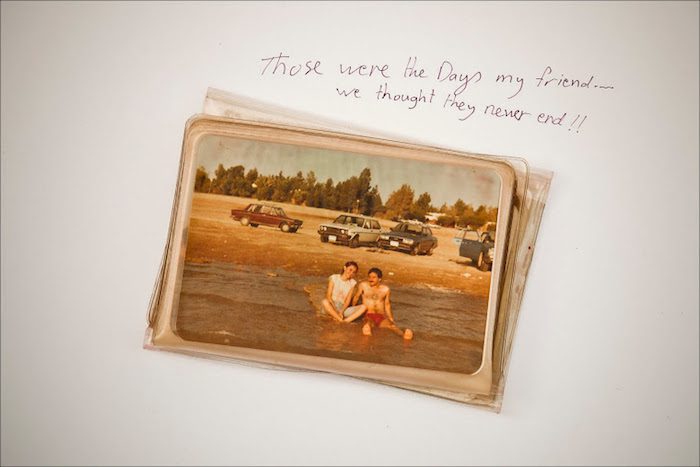
|
| Baher Butti, an Iraqi refugee, captioned this photo of him and his wife for What We Carried |
DEARBORN — In a sepia-tinted photo, Baher Butti sits in shallow water near the shore of a lake with his wife, Balsam. Boxy cars are parked behind them. Tall trees line the back of the frame.
It was 1984 and the couple was on their honeymoon in Baghdad, the beloved city they were forced to leave.
“Those were the days, my friend…we thought they never end!!” Butti captioned the photo at the request of his friend Jim Lommasson.
Lommasson, a freelance photographer, captures mementos like Butti’s picture through “What We Carried: Fragments from the Cradle of Civilization.” The photo project documents the possessions Iraqi and Syrian refugees prized enough to bring on their journey to the United States.
“These are memories and the idea is that those days will never be here again,” said Butti, who left Iraq in 2006 and resettled in Portland, Oregon the following year. “It’s too late by age and by locality.”
Lommasson said because Iraq largely entered American consciousnesses after the Iraq War, many don’t think of its citizens being nostalgic for their country.
“We just think of it as an oppressed time and we think that nobody was ever happy in Iraq,” Lommasson said.
He added that what they see now are refugees and that creates a division between them.
“So much of my project is trying to say, ‘we’re all alike,’” he said.
One example of that similarity was a young girl who brought Barbie dolls with her — like any other child might. Teacups, Bibles, Qur’ans and flags are other items that refugees carried and Lommasson photographed.
Maybe, he mused, the images will prompt viewers to ask themselves what they would take if they had to leave their homes without loading a U-Haul trailer, without thinking and carefully packing things into boxes.
Lommasson began “What We Carried” in Portland in 2010. He initially focused on Iraqi refugees, who make up a population of nearly 2,000 in that city.
The project has since expanded to include Syrian refugees and the cities of Boston, Chicago, Washington, D.C. and Dearborn.
The Arab American National Museum will feature an exhibit of approximately 80 pieces from “What We Carried.” The exhibit is scheduled to open in June and will likely run through October.
Elizabeth Chilton, manager of curatorial affairs for the museum, said other artists address similar topics, but the quality of Lommasson’s work is exceptional.
“We love the idea of this exhibit so much that we are going to use both of our traveling exhibit galleries to display his work,” Chilton said. “That’s very unusual for us.”
Between the two galleries, the exhibit will cover about 2,100 square feet.
Chilton said “What We Carried” is well-aligned with the museum’s intents and themes.
“I think it’s going to be a really touching, emotional exhibit,” she said. “But some of them are really fun and funny, so it kind of runs the gamut.”
Butti echoed Chilton’s comments, saying the depth of Lommasson’s work is impressive. He described “What We Carried” as a type of anthropological study.
“It is a way of giving the individual person an opportunity to reflect on his life,” Butti said.
Lommasson photographs refugees’ objects on a plain white background. He prints the image and returns it to the refugee who then captions it with an explanation of the object’s significance.
Lommasson said the refugees who participated in the project — collaborators as he calls them — have been eager to share their stories. And what they write undoubtedly adds meaning to the photos, he said.
“It becomes totally transcendent,” Lommasson said. “I believe in that social practice of including the subject in the project and being as invisible as I can be.”
The objects individuals carried also becomes suggestive of everything they left behind: the rest of their belongings, their home, their school, their friends, their culture. They share stories about their country and experience that are often heartbreaking.
“Don’t spend tears because you are away from our country. Our country will always be in our hearts,” reads the caption of one object in the collection. It is a photograph of a man standing in front of a towering sculpture.
“These things are artifacts now,” Lommasson said. “Certainly they don’t carry the weight of the artifacts that are being destroyed right now by ISIS, but these are part of their history.”
Origins of the project
Through a project about returning soldiers, published as a book called “Exit Wounds”, and now with “What We Carried”, Lommasson’s work centers on the consequences of war.
Many factors influenced that focus. His father was a WWII veteran who didn’t talk much about his service until old age and dementia loosened his lips. That urged Lommasson to share the experiences of those who served in the Middle East, for the sake of the soldiers as well as civilians. Lommasson also aimed to counter the xenophobic sentiments that became prevalent in the aftermath of 9/11.
Lommasson, a recipient of the Dorothea Lange–Paul Taylor Prize from The Center for Documentary Studies at Duke University, began “What We Carried” with a simple format — personal narratives paired with portraits.
“As with most things, I start out with what I think is the big idea, and then I realize: stupid idea,” Lommasson said.
After about six months of photographing refugees in their new U.S. homes, he realized the items they had brought with them told a more important, comprehensive story.
Since the early days of his career, Lommasson has built his work around a simple question: “So what?”
“I wanted my photographs to matter,” he said.
For “What We Carried”, Lommasson’s answer to that question is giving a voice to those who have otherwise fled their homelands in silence and building a bridge between them and the communities where they now live.






Leave a Reply